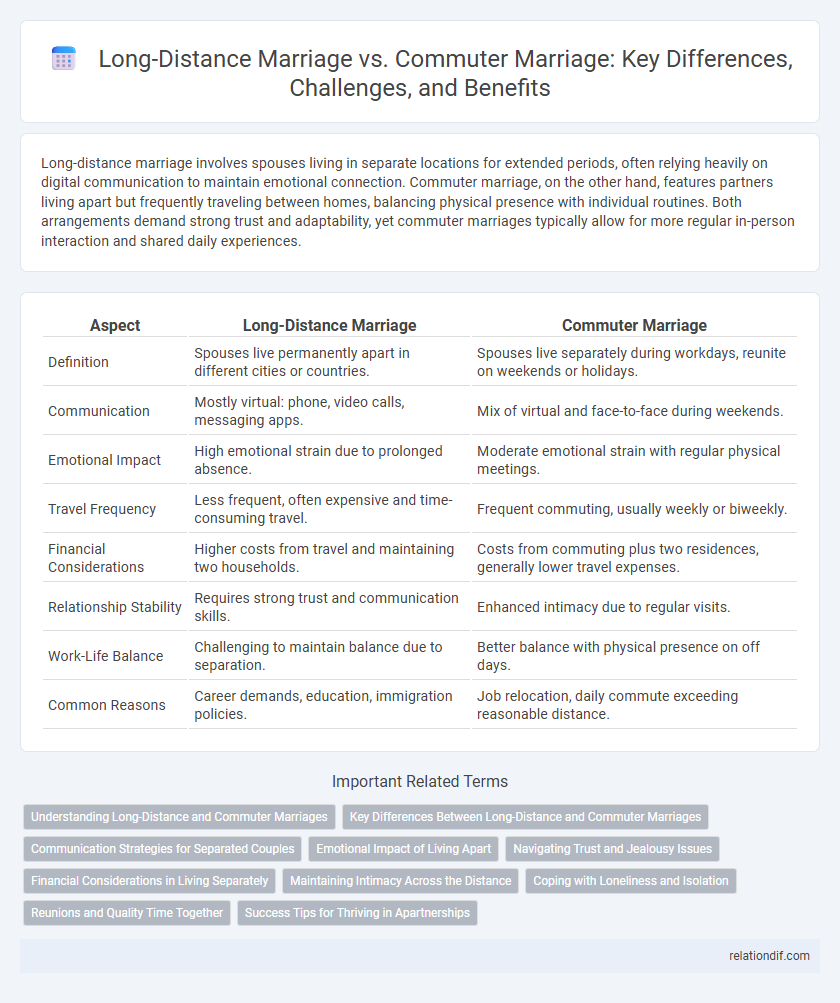Long-distance marriage involves spouses living in separate locations for extended periods, often relying heavily on digital communication to maintain emotional connection. Commuter marriage, on the other hand, features partners living apart but frequently traveling between homes, balancing physical presence with individual routines. Both arrangements demand strong trust and adaptability, yet commuter marriages typically allow for more regular in-person interaction and shared daily experiences.
Table of Comparison
| Aspect | Long-Distance Marriage | Commuter Marriage |
|---|---|---|
| Definition | Spouses live permanently apart in different cities or countries. | Spouses live separately during workdays, reunite on weekends or holidays. |
| Communication | Mostly virtual: phone, video calls, messaging apps. | Mix of virtual and face-to-face during weekends. |
| Emotional Impact | High emotional strain due to prolonged absence. | Moderate emotional strain with regular physical meetings. |
| Travel Frequency | Less frequent, often expensive and time-consuming travel. | Frequent commuting, usually weekly or biweekly. |
| Financial Considerations | Higher costs from travel and maintaining two households. | Costs from commuting plus two residences, generally lower travel expenses. |
| Relationship Stability | Requires strong trust and communication skills. | Enhanced intimacy due to regular visits. |
| Work-Life Balance | Challenging to maintain balance due to separation. | Better balance with physical presence on off days. |
| Common Reasons | Career demands, education, immigration policies. | Job relocation, daily commute exceeding reasonable distance. |
Understanding Long-Distance and Commuter Marriages
Long-distance marriages involve spouses living in separate locations, often due to work or educational commitments, while commuter marriages occur when partners reside apart during the workweek but reunite regularly on weekends. Both arrangements require strong communication skills, trust, and deliberate efforts to maintain emotional intimacy despite physical separation. Understanding the unique challenges and benefits of each can help couples develop strategies to strengthen their relationship and manage distance effectively.
Key Differences Between Long-Distance and Commuter Marriages
Long-distance marriages require couples to maintain emotional intimacy and communication exclusively through digital means, often facing challenges related to time zone differences and limited physical interaction. Commuter marriages involve partners living separately due to work commitments but typically returning home regularly, allowing more frequent in-person contact and shared household responsibilities. The key differences lie in the frequency of face-to-face meetings, methods of communication, and the balancing of individual and shared life routines.
Communication Strategies for Separated Couples
Effective communication strategies for long-distance and commuter marriages center on consistent, transparent dialogue using digital tools like video calls, messaging apps, and shared calendars to maintain emotional connection and coordination. Establishing regular check-ins and setting communication expectations help manage time zone differences and busy schedules, reducing misunderstandings and fostering trust. Prioritizing active listening and empathy during conversations enhances mutual support and strengthens relationship resilience despite physical separation.
Emotional Impact of Living Apart
Living apart in both long-distance and commuter marriages often leads to feelings of loneliness and emotional strain due to limited daily physical interaction. Long-distance marriages typically face greater challenges in maintaining intimacy and trust, as partners rely heavily on digital communication. In commuter marriages, although physical separation is temporary, the recurring cycles of separation and reunion can create emotional exhaustion and stress.
Navigating Trust and Jealousy Issues
Long-distance marriages require clear communication and consistent reassurance to build trust and manage jealousy despite physical absence. Commuter marriages, while allowing more frequent contact, challenge couples to maintain emotional intimacy amid daily separations and potential suspicions. Strategies such as scheduled virtual check-ins, transparent sharing of social activities, and setting mutual boundaries are essential to navigating trust and jealousy in both relationship types.
Financial Considerations in Living Separately
Long-distance marriages often incur higher travel costs due to frequent flights or long-distance transportation, significantly impacting the couple's budget. Commuter marriages, while involving daily or weekly travel, may have lower accommodation expenses if one partner maintains a primary residence, but increased expenses in daily commuting and dual housing. Both arrangements require careful financial planning to balance transportation, accommodation, and living costs while maintaining emotional connection.
Maintaining Intimacy Across the Distance
Maintaining intimacy in long-distance and commuter marriages requires intentional communication strategies, such as daily video calls, shared digital activities, and regular emotional check-ins that reinforce connection despite physical separation. Couples also benefit from setting clear expectations and scheduling frequent visits to nurture trust and emotional closeness, mitigating the challenges posed by distance. Utilizing modern technology and fostering open, honest dialogue plays a critical role in sustaining intimacy and relationship satisfaction in both marriage types.
Coping with Loneliness and Isolation
Long-distance marriages often require partners to develop strong communication skills and emotional resilience to cope with the loneliness and isolation caused by physical separation. In contrast, commuter marriages, where couples live separately but in closer proximity, may face less intense feelings of isolation yet still demand deliberate efforts to maintain emotional connection through scheduled visits and shared routines. Both types benefit from technology-driven interactions and proactive mental health strategies to sustain intimacy and prevent loneliness.
Reunions and Quality Time Together
Long-distance marriages often feature infrequent but deeply meaningful reunions, where couples maximize quality time through focused communication and shared activities. Commuter marriages allow for more regular physical presence, fostering consistent emotional connection and day-to-day support despite separate living arrangements. Both arrangements require intentional effort to maintain intimacy and strengthen relationship bonds during periods apart.
Success Tips for Thriving in Apartnerships
Maintaining trust and open communication is essential for success in both long-distance and commuter marriages, as these elements foster emotional connection despite physical separation. Regularly scheduled visits and shared activities help sustain intimacy and reinforce commitment, reducing feelings of isolation. Utilizing technology for daily interactions and setting clear expectations about future goals enhances mutual understanding and strengthens the partnership.
long-distance marriage vs commuter marriage Infographic

 relationdif.com
relationdif.com